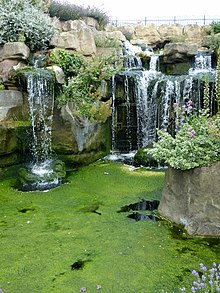
Pulhamite was a patented anthropic rock material invented by James Pulham (1820–1898) of the firm James Pulham and Son of Broxbourne in Hertfordshire. It was widely used for rock gardens and grottos.
Overview
Pulhamite, which usually looked like gritty sandstone, was used to join natural rocks together or crafted to simulate natural stone features. It was so realistic that it fooled some geologists of the era. The recipe went to the grave with the inventor. Modern analysis of surviving original Pulhamite have shown it to be a blend of sand, Portland cement and clinker sculpted over a core of rubble and crushed bricks. It can be viewed in these places:
- Dane Park, Margate
- Neo-Norman gatehouse and folly at Benington Lordship in Hertfordshire
- Rockery, Burslem Park
- Cascade and Rock Garden, Ramsgate,
- Courtstairs Chine, Ramsgate,
- Garden Folly, Sydenham Hill Wood, Sydenham, London.
- Grottoes at Dewstow Gardens, South Wales
- Dunorlan Park, Tunbridge Wells
- Felixstowe Spa and Winter Garden, Suffolk
- Fernery and waterfall, Bromley Palace Park, Bromley
- Grotto, Wotton House, Surrey
- Water course and pump tower, The Dell, Englefield Green
- Henley Hall, Shropshire
- Lake and rockery, Milton Mount Gardens, Crawley
- Leonardslee, rockery in Grade I listed garden at Lower Beeding, near Horsham, West Sussex, England.
- Newstead Abbey fernery, Nottinghamshire
- Rock Cliff, Bawdsey Manor, Suffolk
- Water Garden, Highnam Court, Gloucester
- Zig-zag Path, Lower Leas Coastal Park, Folkestone
- Rosshall Park, Glasgow
- Gardens at Waddesdon Manor, Buckinghamshire
- Heythrop Park, Oxfordshire
- Fernery at Danesbury Park, Hertfordshire.
- Waterfall at Battersea Park, London.
- Madresfield Court and gardens, Worcestershire
- Gardens at Coombe Wood, Croydon.
- Colney Hall near Norwich
- Cliffs at North Shore, Blackpool
- Former Terraced Gardens, Rivington, Lancashire.
Gallery
-
 Pulhamite cliff walk at Bawdsey Manor
Pulhamite cliff walk at Bawdsey Manor
-
 Folly in Sydenham Hill Wood
Folly in Sydenham Hill Wood
-
 Pulham rocks in the Water Garden at Waddesdon Manor estate
Pulham rocks in the Water Garden at Waddesdon Manor estate
-
 Zig-zag Path in Folkestone
Zig-zag Path in Folkestone
-
 Pulhamite grotto at Wotton House, Surrey
Pulhamite grotto at Wotton House, Surrey
See also
References
- Marion Harney (2014). Gardens and Landscapes in Historic Building Conservation. John Wiley & Sons. p. 460. ISBN 978-1118508138.
- "The Pulham Legacy". Archived from the original on 2008-03-29. Retrieved 2008-03-19.
- James Stevens Curl and Susan Wilson (2015). The Oxford Dictionary of Architecture. Oxford University Press. p. 606. ISBN 978-0199674985.
- Margate
- "Rock Gardens and Cascade, Ramsgate". www.britishlistedbuildings.co.uk. Retrieved 21 February 2014.
- "Courtstairs Chine, Ramsgate". Parks & Gardens. Retrieved 27 August 2021.
- "History of Dunorlan Park". tunbridgewellsmuseum.info. 2013. Archived from the original on 7 January 2014. Retrieved 6 January 2014.
- Historic England. "Cliff Gardens and Town Hall Garden (1001220)". National Heritage List for England. Retrieved 22 September 2014.
- "Pulhamite Fernery, Bromley Palace Park, Bromley". britishlistedbuildings.co.uk. Retrieved 21 February 2014.
- "Pulhamite Waterfall in Bromley Palace Park, Bromley". www.britishlistedbuildings.co.uk. Retrieved 21 February 2014.
- "Pulhamite Rock Islet in Lake at Milton Mount Gardens (Former Worth Park), Crawley". britishlistedbuildings.co.uk. Retrieved 21 February 2014.
- "Pulhamite Rockery at Milton Mount Gardens (Former Worth Park Gardens), Crawley". britishlistedbuildings.co.uk. Retrieved 21 February 2014.
- Slade, Naomi (July 2022). "Starting a colourful new chapter". The Garden. 147 (4): 100–106.
- "About Newstead Abbey". www.nottinghamcity.gov.uk. 2012. Archived from the original on 4 January 2014. Retrieved 3 January 2014.
- "Bawdsey Manor Pulhamite Cliff Structures, Bawdsey". britishlistedbuildings.co.uk. Retrieved 21 February 2014.
- "Pulhamite Water Garden". britishlistedbuildings.co.uk. Retrieved 5 May 2014.
- "Pulhamite Caves, Folkestone". britishlistedbuildings.co.uk. Retrieved 21 February 2014.
- "Explore the gardens - Waddesdon Manor". Waddesdon Manor. Retrieved 2017-05-04.
- https://democracy.blackpool.gov.uk/documents/s49453/Appendix%20A%20Cabin%20Lift.pdf Archived 2021-12-07 at the Wayback Machine
- Harris, John (13 April 2021). "1903 – Rivington, Lever Park, Lancashire Pulham's Rivington Ravine… and more!". The Pulham Legacy. Retrieved 11 November 2021.
External links
- The Pulham Legacy
- Durability Guaranteed – Pulhamite Rockwork Archived 2015-12-22 at the Wayback Machine pdf file on the English Heritage website.
- The Story of Pulhamite Rockwork
- Pulham at Waddesdon Manor video